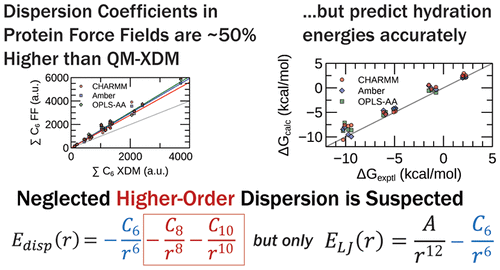当前位置:
X-MOL 学术
›
J. Phys. Chem. B
›
论文详情
Our official English website, www.x-mol.net, welcomes your
feedback! (Note: you will need to create a separate account there.)
Evaluating the London Dispersion Coefficients of Protein Force Fields Using the Exchange-Hole Dipole Moment Model
The Journal of Physical Chemistry B ( IF 2.8 ) Pub Date : 2018-06-22 , DOI: 10.1021/acs.jpcb.8b02814 Evan T. Walters 1 , Mohamad Mohebifar 1 , Erin R. Johnson 2 , Christopher N. Rowley 1
The Journal of Physical Chemistry B ( IF 2.8 ) Pub Date : 2018-06-22 , DOI: 10.1021/acs.jpcb.8b02814 Evan T. Walters 1 , Mohamad Mohebifar 1 , Erin R. Johnson 2 , Christopher N. Rowley 1
Affiliation

|
London dispersion is one of the fundamental interactions involved in protein folding and dynamics. The popular CHARMM36, Amber ff14sb, and OPLS-AA force fields represent these interactions through the C6/r6 term of the Lennard-Jones potential, where the C6 parameters are assigned empirically. Here, dispersion coefficients of these three force fields are shown to be roughly 50% larger than values calculated using the quantum mechanically derived exchange-hole dipole moment (XDM) model. The CHARMM36 and Amber OL15 force fields for nucleic acids also exhibit this trend. The hydration energies of the side-chain models were calculated using REMD-TI for the CHARMM36, Amber ff14sb, and OPLS-AA force fields. These force fields predict side-chain hydration energies that are in generally good agreement with the experimental values, which suggests that the total strength of aqueous dispersion interactions is correct, despite C6 coefficients that are considerably larger than XDM predicts. An analytical expression for the dispersion hydration energy using XDM coefficients shows that higher-order dispersion terms (i.e., C8 and C10) account for roughly 37.5% of the hydration energy of methane. This suggests that the C6 dispersion coefficients used in contemporary force fields are elevated to account for the neglected higher-order terms.
中文翻译:

使用交换孔偶极矩模型评估蛋白质力场的伦敦弥散系数
伦敦分散是蛋白质折叠和动力学涉及的基本相互作用之一。流行的CHARMM36,Amber ff14sb和OPLS-AA力场通过Lennard-Jones势的C 6 / r 6项表示这些相互作用,其中C 6参数是根据经验分配的。在这里,这三个力场的弥散系数显示为大约比使用量子机械导出的交换孔偶极矩(XDM)模型计算出的值大50%。核酸的CHARMM36和琥珀色OL15力场也显示出这种趋势。使用REMD-TI对CHARMM36,Amber ff14sb和OPLS-AA力场计算了侧链模型的水合能。这些力场预测的侧链水合能与实验值基本吻合,这表明尽管C 6,水分散体相互作用的总强度是正确的系数比XDM预测的要大得多。使用XDM系数对分散体水合能的分析表达式表明,高阶分散项(即C 8和C 10)约占甲烷水合能的37.5%。这表明提高了现代力场中使用的C 6弥散系数,以解决被忽略的高阶项。
更新日期:2018-06-22
中文翻译:

使用交换孔偶极矩模型评估蛋白质力场的伦敦弥散系数
伦敦分散是蛋白质折叠和动力学涉及的基本相互作用之一。流行的CHARMM36,Amber ff14sb和OPLS-AA力场通过Lennard-Jones势的C 6 / r 6项表示这些相互作用,其中C 6参数是根据经验分配的。在这里,这三个力场的弥散系数显示为大约比使用量子机械导出的交换孔偶极矩(XDM)模型计算出的值大50%。核酸的CHARMM36和琥珀色OL15力场也显示出这种趋势。使用REMD-TI对CHARMM36,Amber ff14sb和OPLS-AA力场计算了侧链模型的水合能。这些力场预测的侧链水合能与实验值基本吻合,这表明尽管C 6,水分散体相互作用的总强度是正确的系数比XDM预测的要大得多。使用XDM系数对分散体水合能的分析表达式表明,高阶分散项(即C 8和C 10)约占甲烷水合能的37.5%。这表明提高了现代力场中使用的C 6弥散系数,以解决被忽略的高阶项。











































 京公网安备 11010802027423号
京公网安备 11010802027423号